Punta Arenas, Chile
[by Paula]
It would be fair to say that Christmas Day 2014 did not begin with a cheery festive smile.
Anyone that knows me will be aware that without an early morning cup of tea, I am a non-functioning mess of a sub-human, as well as being really very unhappy.
Jeremy knows this more than anyone. So when he put the kettle on on Christmas morning, only to hear the propane gas go put-put-pssssh, he was really very afraid.
We’ve only ever run out of gas once before, so for this to happen on that day of all days was pretty unlucky. Filling up in Argentina is tricky at the best of times, but over a public holiday? No chance.
Luckily, the night before we´d bumped into road-trippers Adam, Emily and their little girls Coco and Sierra – of Our Open Road – at our campsite in Esquel. Their Christmas wasn´t going brilliantly either, as their VW camper was in serious trouble and they were trying to find mechanics and parts during the shut-down. On top of that, they´d also run out of propane weeks before and couldn´t find a place to fill up.
They generously let us use some of the final trickle of gas in their back-up camp stove and equilibrium was restored. Over breakfast, we launched Project Forgetallthat-drinkwine-buildabigfireandcookchristmasdinneronit.
We didn´t feel too sorry for ourselves as we tucked into rum, baked cheese, a load of steaks, potato salad and pears poached in red wine. Crisis averted!
Adam and Emily set off from California more than two years ago, with little Coco in tow. Last summer, Sierra was born while they were in Brazil. They look lovely and sweet, don´t they?
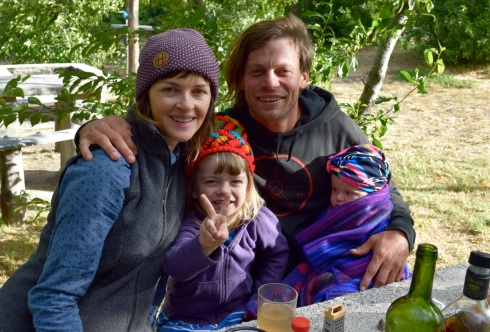
Our Christmas companions Emily, Adam, Colette (Coco) and Sierra, who’ve been journeying through LatAm in a VW campervan and blogging at ouropenroad.com
That may be so, but I’m still holding them responsible for the first two-day hangover I´ve had in a very long time. Ouch.
On hangover day two, some serious carbs were needed. We drove to the nearby town of Trevelin, one of several communities established by Welsh settlers 150 years ago. These towns, in the region of Chubut, still retain much of that character to this day – something we were delighted to take advantage of by indulging in a Welsh afternoon tea. This involved five types of cake, a scone and jam, a cheese and ham sandwich, homemade bread and unlimited tea.
In the spirit of festive excess, we ordered one each, which was entirely unnecessary and almost led to a cake coma.
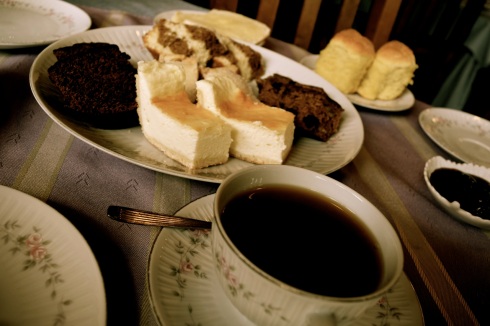
I think we may have over-ordered. Welsh tea of five types of cake, sandwich, homemade bread, scones with jam and unlimited tea. Each.
We spent a painful morning trying to fill our propane tank at a shop in Esquel, with a guy who obviously had no clue what he was doing. Only a trickle of gas went into the tank, but it would do for a few days, we hoped.
Having fully expected to spend Christmas and New Year alone, we were very happy to then hear from our Swiss friends Rike and Martin (see Rike-Martin on Tour!), whom we´d first encountered in Buenos Aires, and were in the area. We met at the nearby Parque Nacional los Alerces, and spent an excellent night camping together with a fire and plenty of food and wine.
We could have lingered at that lovely lakeside spot, but were feeling an itch to make some headway on the road south, so set off to tackle the long, isolated, infamous Ruta 40. Some people say this route from northern to southern Patagonia is boring. Boring is an over-used, abused, word. Sure, it’s a very long and straight road and there aren’t very many towns, nor roadside cafes, nor big sights to see.
But so what? It takes a lot more than that for us to declare we’re bored. Besides, there was all the excitement of not knowing if we’d get stranded in the middle of nowhere because we couldn’t get hold of enough petrol.
Whilst in theory there are plenty of petrol stations to get you down the Ruta 40, they don’t always have petrol in them. At Tecka we had to drive on because the gas station was empty. At the next town it was the same!
“The delivery truck should be here by 10pm” said the pump attendant.
He suggested we went off to find a campsite and come back in the morning but, at 5pm, there was already a queue forming in anticipation of the delivery that night. Now, we Brits cannot resist a queue. So we accepted that was the end of driving for the day, got in line, popped the roof, cooked some dinner and settled down with a movie for the evening.
In the town of Perito Moreno we picked up two French hitch-hikers, Alex and Marie. We were only planning to drive about 80km that day, with the hope of spending new year’s eve at a place where we could do a long hike to a famous cave filled with ancient paintings.
“Sounds good,” they said. “We’ll join you and do the hike too.”
Due to sheets of relentless rain and a closed campsite, we never did make it to the cave. But we made some lovely friends, with whom we were still travelling 10 days later.
So new year’s eve was looking like a bit of a washout. We agreed to just keep driving until…erm… we stopped.
What was definitely not boring was the amount of wildlife we saw – herds of guanacos, rheas (or ñandús, which are like ostriches) racing along the plains, and even pink flamingos mingling with sheep within view of the road.
When we got to Bajo Caracoles it felt more like the middle of nowhere as just about anywhere we’d seen. It had that wild west feel about it – a couple of petrol pumps adorned with stickers from passing travellers, a ‘hotel’ and shop that combined with the gas station, a howling freezing wind, black skies and nothing else. There was a restriction on the amount of petrol they could sell – we took our half-tank allocation and kept going.
About 200km on, the curiously named town of Gobernador Gregores was where we decided to hang our hats for new year. The sheer randomness of it was somehow quite appealing. Not least because for quite some weeks Jeremy had kept looking at Gobernador Gregores on the map and declaring how he wanted to go there, imagining it to be a fascinating outpost, being the only proper town for miles and having such an odd name.
Well he got his wish, we’d be spending new year there! It was actually quite nice – we pulled into a sweet little municipal campsite which was free for anyone kind enough to visit. Result. We fired up the BBQ, cooked some meat and enjoyed a remarkably sunny evening. At midnight the town’s skies filled with fireworks, and we were treated to a free show from the campground.
Next day we took our fuzzy New Year’s Day heads down the last unpaved 80km section of the the Ruta 40 which, after all the rains, was a quagmire. Bump, bump, splash, ouch. We were all knackered but elated when we arrived in El Chalten, the ‘trekking capital’ of Argentina at the north end of the Glaciers National Park.
The views of the Fitz Roy mountain range as we approached the town were phenomenal. It’s another area where the weather can deteriorate in a moment, clouds obscuring the very sights you’ve come to see, but luck was on our side again.
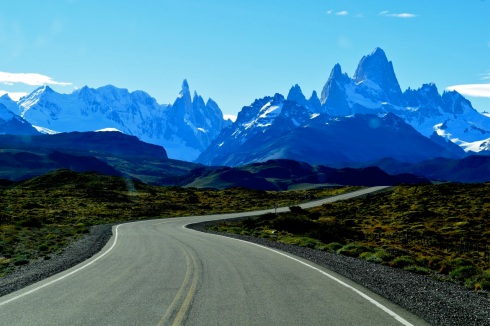
Incredible views as we approached El Chalten and the Fitz Roy mountain range. Parque Nacional Los Glaciares, Argentina.
El Chalten was insanely busy. As the four of us pulled up at the campsite, we gaped in disbelief. We’d heard Patagonia was popular in summer but we’d never seen a place so packed with rows and rows of motorhomes and tents – overall we’d had a really quiet three and half years on the road, seeing just handfuls of other campers at any one time, and mostly seeing no one, so where had they all come from?!
We were all there to see what was some of the most incredible scenery in the country – jagged granite towers, luminous lakes and giant glaciers. We made the most of a few days of good weather and got out on some day treks. Setting off very early to avoid the crowds, we were particularly lucky to enjoy a tranquil few hours of glorious weather on the way to Laguna de los Tres.
A bit like some of the other huge highlights on this trip, this area’s beauty kind of defies adequate description.
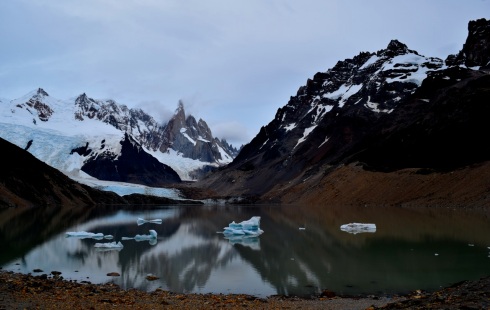
We got some good views of the towers before the sun pushed the clouds down onto them. Laguna Torre, Parque Nacional Los Glaciares, Argentina.
While the weather was relatively good, at times the wind was ferocious, freezing and energy-sapping. We were occasionally forced to pull the van’s pop-top down, for fear it would be ripped off in the gusts. Welcome to southern Patagonia.
As the weather truly dive-bombed, we headed off again – Alex and Marie still happily ensconced in the back with their backpacks and tent. The sun returned as we made our way to the southern end of the park at El Calafate.
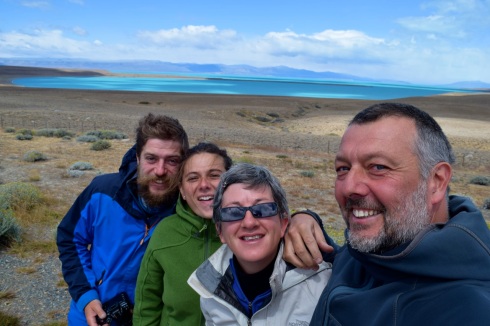
Driving to El Calafate. Alex and Marie hitch-hiked with us on new year’s eve, and we were still travelling together 10 days later!
Finding a lovely family-owned, wind-sheltered spot for camping, we settled in for a few days. Next morning, we ran out of propane again, and the local gas plant didn’t have the equipment to fill it. Argh!
This time it was Alex and Marie to the rescue! We could improvise on evening meals for a few days but quickly grasping our need for tea in the morning, they boiled water on their tiny camping stove every day and made ‘home deliveries’ to the van with a little thermos flask. Now that’s human compassion for you, and we’ll never forget it.
But really, should we keep banging on about propane when one of the most remarkable sights in South America was on our doorstep?
The biggest draw to this part of the national park is the 250km-sq Perito Moreno glacier – a beast of a block of ice at around 5km wide, 30km long and an average of 60m high. And the beast lives – it advances along the valley by about two metres per day, causing noisy, dramatic ice falls and much ooh-in and ah-ing from the watching crowds.
We spent hours and hours gazing at it from every angle. Who would have thought one could watch ice for the best part of a day? Unforgettable.
The propane situation (see, I just couldn’t let it lie) was one reason we decided to slightly change the route we assumed we’d take – we’d have to divert eastwards and drive to the city of Rio Gallegos for a refill. It meant we’d be taking a faster route to ‘the end of the road’, at Ushuaia, and coming back up the slower way.
We said a sad goodbye to our French companions, and suddenly it all seemed real – maybe we really were going to make it to Tierra del Fuego?! Then what would we do?
The end was nigh.
Days: 1,215
Miles: 31,554
Things we now know to be true: Life is not worth living without tea.
MORE PHOTOS IN GALLERY BELOW! [CLICK ON ANY PHOTO TO OPEN THE GALLERY]


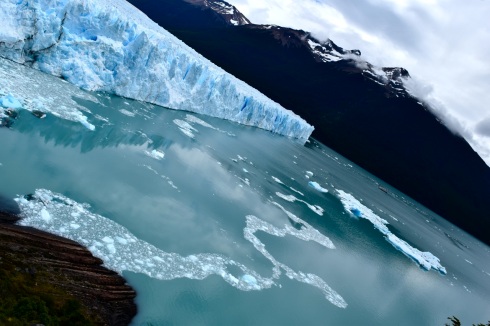




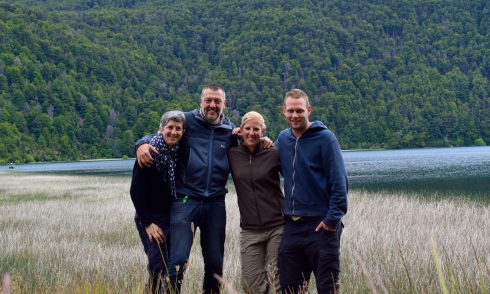
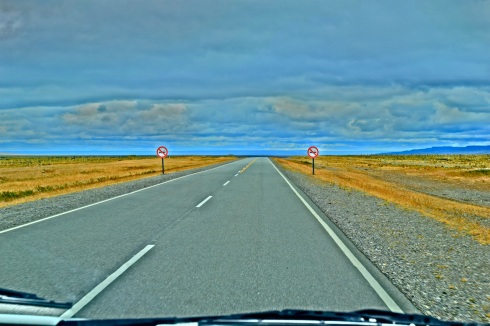
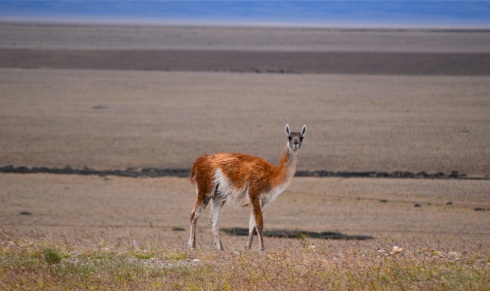
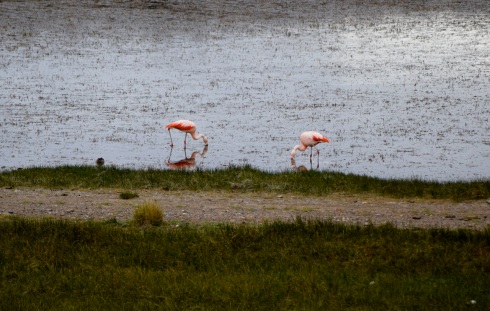
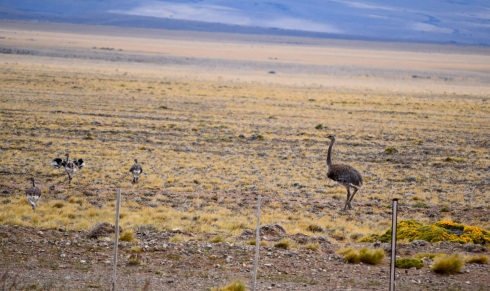
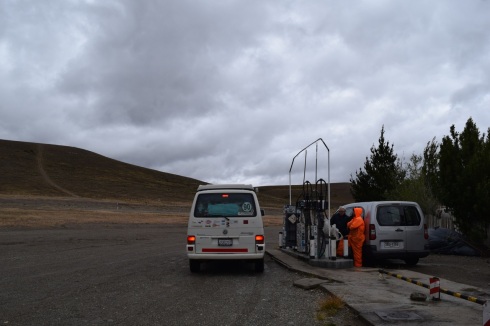

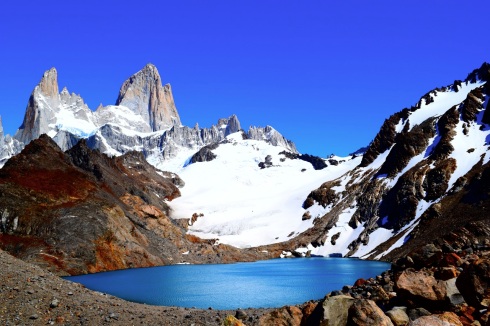

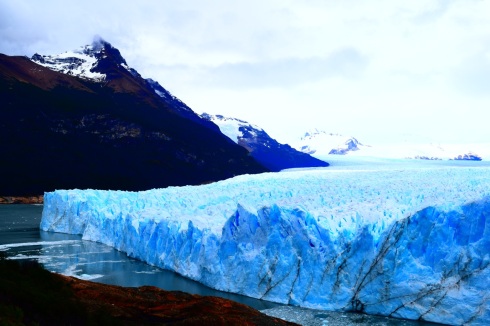




































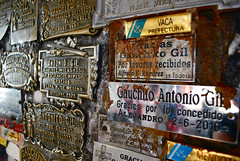


Those blue colours… it’s really something I remember so well from Patagonia.